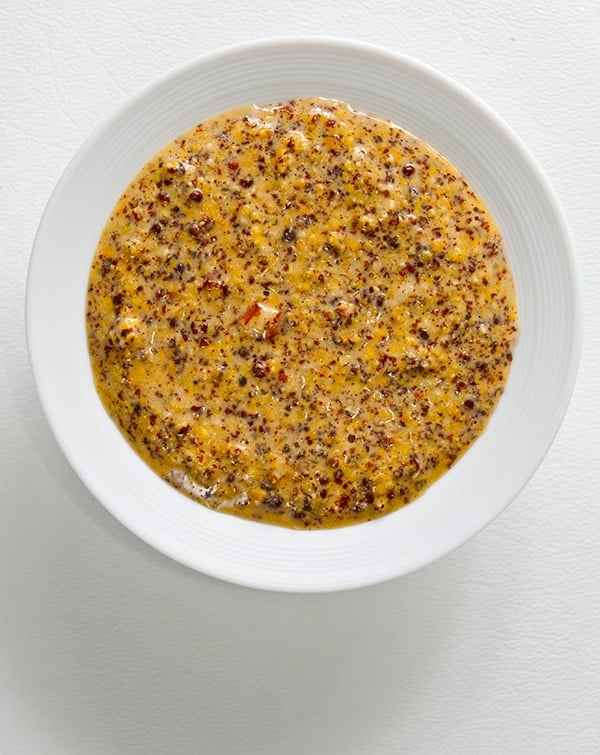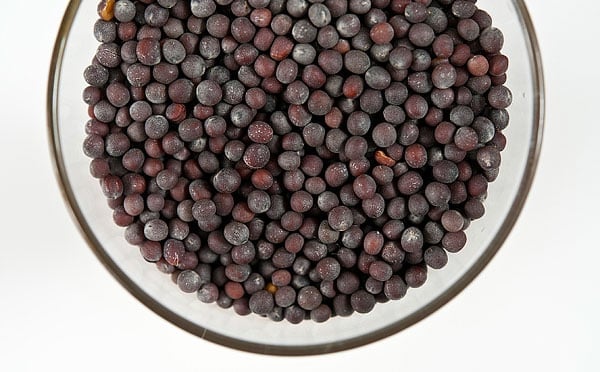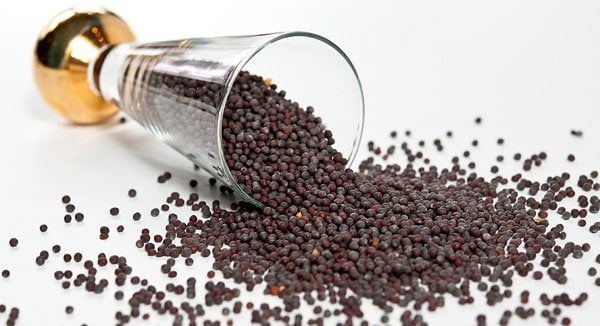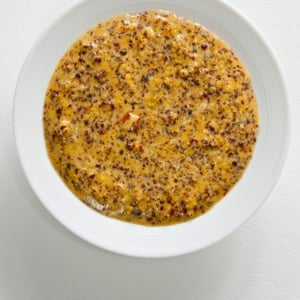As an Amazon Associate I earn from qualifying purchases.

What do you mean you can make mustard at home? It was all I could do not to say, “Uh… how did you think it was made? By mustard elves under a tree?” Instead, I said, “Why yes, and it is really, really easy to make.”
I had this conversation years ago with another food blogger, and I tell you this because for even a food person to not know how to make mustard tells me that it must appear to be magic to most people. But it ain’t. If you have mustard seed and water, you can make mustard.
It’s that easy. And pretty much every culture in the Northern Hemisphere has done so: Mustard is to the North what chiles are to the tropics.
Mustard is a condiment of a thousand faces. Some are smooth, others almost entirely made from barely cracked seeds. Vinegar is often used, but wine, beer, grape must, and even fruit juices are used to moisten the seeds.
Sweetness is usually achieved by adding honey; an American “honey mustard” can be a 1:1 ratio of mustard to honey. A Bavarian sweet mustard, however, uses only sugar and water: no acid, no honey. Italians put fruit preserves in their mustard.
Mustard is one of Europe’s few native spices, although it also has been used in Chinese cooking for around 2,500 years as well. Ancient Rome was quite the hotbed of mustard-making, and it is Rome that gives us our name for mustard: It is a contraction of mustum ardens, or “hot must;” the Romans often added crushed mustard seeds to unfermented crushed grapes.
I’ve recreated a Roman recipe for mustard that uses almonds, pine nuts, mustard seed and red wine vinegar.
The basic idea behind making mustard is this: Grind seeds and add liquid. At its most basic, this is all mustard is. Both Chinese and English mustard (think Coleman’s) is nothing more than water and mustard powder. But there are some things you need to know to make great mustard.
First, you need cold liquid. What gives mustard its bite is a chemical inside the seeds reacting with cool or cold liquid. You also need to break the seeds to get at the fiery chemical — it’s like cutting an onion. Heat damages this reaction, however, so to make a hot mustard use cold water, and warm water for a more mellow mustard.
Mustard sauces lose punch when long-cooked, and should always have a little extra fresh mustard tossed in at the end of cooking.
This reaction is volatile, too. Left alone, your mustard will lose its bite in a few days, or in some cases even hours. But adding an acid, most often vinegar, sets the reaction in place — this is what happens with horseradish as well. Adding salt not only improves the flavor, but also helps preserve the mustard, too.
If you skip the vinegar and salt, you will still have mustard, but it will not keep for long. Not that it will go bad, but it will lose it’s flavor.
Once made with salt and vinegar, mustard is nearly invulnerable to deterioration. Mustard is one of the more powerful anti-microbial plants we know of, and, considering it is mixed with vinegar and salt, it becomes a heady mix no wee beastie can survive in. It is said that mustard will never go bad, although it can dry out.
You have three choices when it comes to which variety of mustard seed you use: White, brown and black. White mustard undergoes a different, milder reaction than do brown mustard or black mustard, which are far zingier. American yellow mustard is made with white mustard seed and turmeric, brown mustards are in most of your better mustards, and black mustard is used in hot mustards or in Indian cuisine.
(Note: You can tame black and brown mustard seeds by soaking them in water overnight before grinding.)

Incidentally, the wild mustard all over California is black mustard. You can thank Father Junipero Serra for that one: He used mustard, which grows like a weed, to mark his travels in Alta California 250 years ago.
The famous Grey Poupon mustard — Dijon has been a center of mustard-making for nearly a millennium now — is traditionally made with stone ground brown mustard and verjus, the tart juice of unripe grapes. I prefer this style of mustard, and most of my homemade mustards are grainy like Dijon. I grind my seeds with a spice grinder, but you could get all old school and use a mortar and pestle.
The best mustards, in my opinion, combine brown or black mustard seeds with yellow mustard powder: The two sets of chemical reactions complement each other and made a more complex mustard.
Always add water or a non-acidic liquid first, let the mixture sit for 10 minutes or so, then add the acid (vinegar, verjus, lemon juice, etc).
Add salt to taste, but it’s typically about 1 to 2 teaspoons per cup of prepared mustard.

Finally, let your mustard set in the fridge or in a cool place for at least a day before you serve it. Bitterness is a byproduct of the mustard reaction, but that bitterness fades after a day or so. Pure mustards can be kept at room temperature, but mustards with other ingredients, like the Roman nut mustard I mention above, should be kept in the fridge.
So there you have it. Easy-peasy. Now you really have no reason to ever buy mustard again.
Basic Country Mustard
Ingredients
- 6 tablespoons mustard seeds, about 50 grams
- 1/2 cup mustard powder, about 50 grams
- 1/2 cup water or beer
- 3 tablespoons vinegar (cider white wine or sherry)
- 2 teaspoons salt, about 5 grams
- 1 teaspoon ground turmeric (optional)
- 2 tablespoons honey (optional)
- 1/4 cup minced fresh herbs (optional)
Instructions
- Grind the whole mustard seeds for a few seconds in a spice or coffee grinder, or by hand with a mortar and pestle. You want them mostly whole because you are using mustard powder, too.
- Pour the semi-ground seeds into a bowl and add the salt and mustard powder. If using, add one of the optional ingredients, too.
- Pour in the water or beer, then stir well. When everything is incorporated, let this sit for up to 10 minutes. The longer you let it sit, the mellower the mustard will be. When you’re ready, pour in the vinegar.
- Pour into a glass jar and store in the fridge. It will be runny at first. Don’t worry, it will thicken up overnight. Wait at least 12 hours before using. Mustard made this way will last a year in the fridge.
Video
Notes
- Change the liquid and you change the mustard.
- Grind the mustard seeds a lot or a little and you change the texture — or skip the whole seeds altogether and use just mustard powder. Or skip the powder and just use seeds.
- Want herbs in there? Go for it.
- Like honey mustard? Pour some honey in.
- Want your mustard even spicier? Add chiles or freshly grated horseradish.
Nutrition
Nutrition information is automatically calculated, so should only be used as an approximation.






Do you have UK measurements for this recipe? Eg UK tablespoon, millilitres instead of 1/2 cup. Want to make sure I have them right, thanks!
Used brown mustard seeds, as they were cheaper, but wasn’t prepared for the initial sinus kick on par with store “wasabi”. I love it! Might use warmer water and let it sit longer for the next batch. Did notice it’s not as spreadable as I thought it might be and tends to lay on thick. Any hints for make it more spreadable?
Heather: Sure. Add more liquid to thin it out.
Excellent recipe and process description. I made one batch, loved it, then bought bulk mustard seeds from Amazon. I did do a slight variation by adding a very small (1/4 t) amount of liquid smoke to a half pint jar of your basic recipe. Oh baby! Smoked mustard! Great on burgers, brauts, and hot dogs!
Thanks so much for this recipe, it’s my new obsession! I’ve been experimenting with different liquids (water, beer, sours, ciders, different ratios of brown to black mustard seeds and different acids. It’s so much delicious fun! And people are always so impressed with my charcuterie spreads! <3
Where do you get your mustard seeds and powder? I would like to try this out but not sure the best place to get the seeds. Thanks!
Sharon: I buy them online. There are many sources.
Penzeys Spices has several varieties of whole seed and powdered mustard. They have stores all over but mail order is always a good way to go
Thank you, thank you, thank you!! I made your recipe a few months ago. And then…. couldn’t find it again. I searched and searched because it was the BEST mustard we have ever had. I needed to add more cider vinegar to loosen it, but it tasted great. I am so glad to have your recipe AND the why and how to make the mustard hotter. This time, I have your recipe saved for the future. Much thanks!! Happy meals to you. 🙂
Hello, I usually use half standard mustard powder and half fresh ground Black seeds. when I do a small batch it comes out really spicy (what I am looking for) . For some reason when i make a bigger batch, say 4X everything. It seems to loose it hotness. Is the a part of the water to mustard powders ration that doesn’t work in a linear recipe up-size???? Any help would be great!. Thanks in advance
MP
Thanks for the entry of science into making mustard! I have been making mustard for a while, and am a believer in the importance of the initial combination of water and mustard powder. However, I have been confused by all the mustard recipes out there that seem to ignore this. Can you verify a couple of things?
Does alcohol (beer or wine) function the same as water for the initial chemical reaction?
Your comments would suggest that this initial chemical reaction does not occur with whole seeds soaked in water, true?
Elizabeth: Yes and yes. Beer or wine work like water here, and no, you need the seeds to be broken to get the reaction. Even roughly cracked will work.
Excellent. So far I have made 4 different varieties, all with cold liquids. I like them all, though they are all quite spicy. I need to experiment some more to make a milder mustard. I had previously tried a couple of other recipes that called for cooking, both made very bitter mustard.
Really like the recipe, and variations: however the measurements are a bit confusing (esp for a newbie): it mentions to use both (about 50 grams) for both mustard seeds and mustard powder, specifically 6Tbs and 1/2 a cup: 6 Tbs is about 90 mls or 90 grams, 1/2 cup is 125 grams (1mL = 1gram), so it’s trial and error – but I’d ignore the mention of 50 grams if you are making this for the first time.
1ml = 1gram of water. Ingredients of different weights and densities will have volumes & weights that don’t correlate.
So many comments about runny mustard I figured I’d admit to leaving mine out on the counter uncovered. I live in a pretty dry place and the longer I leave it out the drier it gets. The drier it gets the more I like it!
Made this using homemade Scottish ale. Perfect for a roast beef sandwich.
hi, used your recipe,used double seeds broken down in pestle. put in jar then into fridge, result was good but very thick,so i have thinned with my cyder vinegar and little water,results tomorrow its back in fridge to rest.
I thin mine out quite a bit as well after 24 hours. Probably an additional 1/2 or 3/4 cup of cold water. Let it sit several more hours and then check. I prefer a sandwich spreadable consistency so I do it this way. Sometimes I’ll make a double batch and split it. Some thin some thick. Just depends how I’m feeling. I haven’t noticed the additional liquid effect the taste, just consistency
I have wild mustard coming up in my garden patch and plan to dry it and use your recipe to make it into mustard! I know it hasn’t been sprayed with anything so it is safely edible. I’ll let you know how it turns out.
I can get the flavors but the liquid tends to float to the top over a period of time. Is this were shake well before use comes in? Why doesnt it remain as a grainy paste? should I use less liquid and blitz it in the blender?
Nihal: All mustards separate, even store bought ones. That’s why the store bought mustards say shake well, or note that you might need to stir before using in cases like Dijon mustard.
Hi Hank, similar – but I had only rice vinegar, and under-crushed my seeds (50 g brown / 50 g white powder), and used cold beer; I under-salted for family who can’t. It’s good, but not great, nor spicy enough, and way too liquid. Can I just add powder now? like 25 g?
thanks!
David
David: Absolutely. That’s how I tinker with it if a batch turns out too runny.
I’m a doer in the kitchen self taught. I can’t remember when I last bought a pizza. Hey, so I don’t like when the nation of origin is missing. I am a refusalnik with some countries. So when I could find it on the mustard, I made my own from your recipe. I’ll never buy factory mustard again thanks to you. And the same I did for relish and made my own with, hey you could guess, cucumber and stuff in vinegar. Vinegar is that secret ingredient that is found in many condiments. Because I am a cat rescuer and have 7 of my own, I make my own cat food because I want to give them the best. And it’s cheaper than factory made bad cat food. Now I want to show others how to make their own. And maybe sell some of my home and if thy don’t want to make it. The world awaits.
Hello,
Can this recipe be made shelf stable by canning for gift giving?
Susan: Mustard by nature is shelf stable.
Hey Hank,
Great recipe! I have been trying all different sorts of mixtures and experiments, having a great time doing it. Just wanted to say thanks for all the recipes and I really enjoyed seeing you with Steve Rinella on Meateater.
I opened my jar from about 9 months ago and found that I didn’t strain all the herbs out of the finished mustard completely. There are a few rosemary leaves floating around in it. Will these make the mustard subject to bacteria or other dangers? Thank you!
Ash: In theory yes, but rosemary is antibacterial.
One batch of excellent mustard and I was hooked.
Thank You for a great, easy to follow process. I have since made every variation you listed and came up with a few variations of my own.